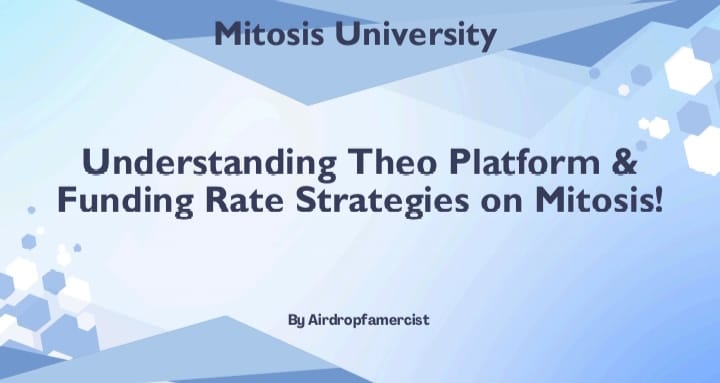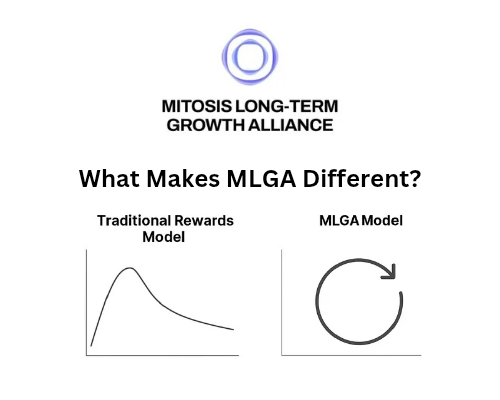Understanding Theo Platform & Funding Rate Strategies on Mitosis!

The decentralized finance (DeFi) landscape is evolving rapidly, with innovative protocols and strategies emerging to address inefficiencies and enhance user opportunities. Among these, the Theo Platform and its integration with Mitosis stand out as a compelling case study in leveraging funding rate strategies to optimize yields and liquidity management.
This article explores the Theo Platform, its funding rate strategies, and how its collaboration with Mitosis—specifically through the Theo Straddle Matrix Vault—creates a powerful framework for DeFi participants.
➛ What is the Theo Platform?
The Theo Platform is a stablecoin network designed to scale DeFi by enhancing capital efficiency and providing users with sophisticated financial tools. Built as a liquidity engine, Theo integrates on-chain smart contracts with off-chain systems to bridge markets across multiple blockchains and trading venues. Its core mission is to empower users—both retail and institutional—to maximize yields and optimize trading strategies while maintaining flexibility and accessibility.
At the heart of Theo’s ecosystem is Theo Earn, an application that allows users to deploy their assets into strategies that capture lucrative opportunities, such as funding rates in perpetual futures markets. Theo’s design emphasizes capital efficiency, meaning users can utilize their assets across various DeFi applications without being locked into rigid structures. This flexibility aligns with the broader trend in DeFi toward user-centric, programmable financial systems.
➛ Funding Rates : A Primer.
In cryptocurrency markets, funding rates are periodic payments exchanged between traders of perpetual futures contracts to keep their prices aligned with the underlying spot market. Unlike traditional futures with expiration dates, perpetual contracts are designed to run indefinitely, and funding rates serve as a mechanism to prevent significant price divergence.
• Positive Funding Rates: When the perpetual contract price exceeds the spot price, long position holders pay short position holders. This typically occurs in bullish markets where demand for long positions is high.
• Negative Funding Rates: When the perpetual contract price falls below the spot price, short position holders pay long holders, common in bearish markets.
Funding rates are influenced by market sentiment, volatility, and the balance of long versus short positions. For traders and liquidity providers, they represent both a cost and an opportunity: a cost if you’re on the paying side, and a profit if you’re on the receiving end. Theo leverages this dynamic to create delta-neutral strategies that capture funding rate profits without exposing users to directional market risk.
➛ Mitosis: The Backbone of Programmable Liquidity.
Mitosis is an Ecosystem-Owned Liquidity (EOL) Layer 1 blockchain that redefines the DeFi liquidity provider (LP) experience. It addresses key challenges in traditional DeFi, such as capital inefficiency, unstable total value locked (TVL), and limited flexibility for LPs. By transforming liquidity into programmable primitives, Mitosis enables users to deposit assets into vaults and receive tokenized positions (e.g., maAssets) that can be used across DeFi applications on its chain.
Mitosis’s Matrix Vaults are a cornerstone of its ecosystem. Unlike the EOL system, where liquidity is pooled and governed collectively, Matrix Vaults allow users to select specific liquidity opportunities tailored to their goals. This curated approach provides greater control and aligns with Theo’s vision of scalable, user-friendly DeFi solutions.
The collaboration between Theo and Mitosis, particularly through the Theo Straddle Matrix Vault, exemplifies how these platforms complement each other.
➛ Theo Straddle: A Delta-Neutral Funding Rate Strategy.
The Theo Straddle Matrix Vault, launched as Mitosis’s inaugural Matrix Vault campaign on February 26, 2025, integrates Theo’s funding rate strategy with Mitosis’s liquidity infrastructure. This delta-neutral product aims to democratize access to institutional-grade yields while solving traditional DeFi liquidity challenges. Here’s how it works:
• Deposits: Users deposit wrapped Ether (weETH) or Mitosis-specific miweETH into vault contracts on supported chains (Ethereum, Arbitrum, or Linea). These assets serve as the collateral for the strategy.
• Deployment: At the start of a vault round (approximately every two days), deposits are deployed into the Straddle strategy.
• Long Leg : weETH is deposited into Aave (a decentralized lending protocol) on the respective chain to borrow USDC.
• Short Leg : The borrowed USDC is bridged to Hyperliquid (a decentralized perpetuals exchange), where it’s used to open a short position on ETH, capturing the funding rate.
• Delta-Neutral Design: The long position (weETH collateral) and short position (ETH perpetuals) offset each other, neutralizing directional price risk. Profits are derived solely from the funding rate differential.
• Rebalancing: As ETH’s price fluctuates, the collateral is automatically rebalanced to maintain the delta-neutral stance, ensuring stability.
• Withdrawals: Users can initiate withdrawals at any time, with processing occurring at the end of each vault round. However, early withdrawals forfeit rewards, incentivizing longer participation.
Upon deposit, users receive tokenized maAssets (e.g., maETH), which represent their vault positions. These tokens remain usable as collateral or in other DeFi strategies, maximizing capital efficiency—a key feature of both Theo and Mitosis.
➛ Benefits of the Theo Straddle on Mitosis.
The Theo Straddle Matrix Vault offers several advantages that align with the goals of modern DeFi:
• Institutional-Grade Yields for Retail: Traditionally, delta-neutral funding rate strategies have been the domain of whales and institutional players with significant capital and expertise. Theo and Mitosis lower the barrier to entry, allowing retail users to access these sophisticated opportunities.
• Flexibility: Unlike many DeFi protocols that impose strict lockup periods, the Straddle Vault allows withdrawals at any time (with the caveat of forfeited rewards). This respects user autonomy while encouraging long-term participation through yield-based incentives.
• Capital Efficiency : The issuance of maAssets ensures that locked liquidity isn’t idle—it can be deployed elsewhere in the DeFi ecosystem, enhancing overall returns.
• Multi-Chain Support : By operating on Ethereum, Arbitrum, and Linea, the vault leverages Mitosis’s cross-chain capabilities, broadening accessibility and reducing gas costs on Layer 2 solutions.
• Risk Management : The delta-neutral approach, combined with conservative risk parameters and automatic rebalancing, minimizes exposure to market volatility.
➛ Funding Rate Strategies: Why They Matter!
Funding rate strategies like the Theo Straddle are particularly appealing in DeFi because they exploit market inefficiencies without requiring directional bets. In bullish markets, perpetual contract prices often exceed spot prices, leading to positive funding rates that shorts can collect.
In bearish markets, the reverse occurs. By maintaining a neutral position, Theo captures these payments regardless of market direction, providing a stable income stream.
For example:
In a bullish scenario with a 0.05% daily funding rate, shorting ETH on Hyperliquid while holding weETH on Aave could yield consistent profits as long traders pay shorts.
In a bearish scenario with a negative rate, the strategy adjusts to benefit from payments flowing in the opposite direction. This approach contrasts with speculative trading, where profits depend on correctly predicting price movements—a riskier proposition. For liquidity providers and yield farmers, funding rate strategies offer a predictable, low-volatility alternative.
Mitosis and Theo: A Synergistic Partnership.
The collaboration between Mitosis and Theo is a natural fit. Mitosis provides the infrastructure—programmable liquidity , cross-chain compability tokenized positions—while Theo brings the financial engineering expertise to design strategies like the Straddle.
Together, they address core DeFi pain points:
• Liquidity Instability: Traditional protocols suffer from mercenary capital that exits when rewards dry up. The Straddle Vault’s flexible withdrawals and yield incentives promote sustainable liquidity.
• Capital Inefficiency: By tokenizing positions, users avoid the opportunity cost of locked assets.
• Accessibility: Multi-chain support and simplified mechanics make advanced strategies available to a broader audience.
As of March 20th 2025, the Theo Straddle campaign is live, with early adopters already depositing weETH and miweETH to participate. The integration with Hyperliquid and Aave showcases the power of composability, a hallmark of DeFi’s evolution.
➛ Challenges and Considerations.
While promising, the Theo Straddle and its funding rate strategy aren’t without risks:
• Smart Contract Risk: Bugs or exploits in Mitosis or Theo’s contracts could lead to losses.
• Funding Rate Volatility: Extreme market conditions could flip funding rates unpredictably, affecting profitability.
• Counterparty Risk: Reliance on Aave and Hyperliquid introduces dependencies on external protocols.
• Adoption Hurdles: Hurdles: Convincing users to trust a new vault system requires education and proven performance.
Mitosis and Theo mitigate these through rigorous audits, conservative risk parameters, and transparent communication, but users should still exercise due diligence.
The Future of Funding Rate Strategies on Mitosis.
The Theo Straddle is just the beginning. As Mitosis prepares for its mainnet launch and Theo expands its suite of financial products, we can expect more innovative vaults and strategies
Potential Development include:
Expanded Asset Support: Beyond weETH, vaults could incorporate BTC, stablecoins, or other liquid restaking tokens (LRTs).
Dynamic Strategies: AI-driven allocation to optimize funding rate capture across multiple markets.
Governance Integration: Allowing LPs to vote on vault parameters, aligning with Mitosis’s EOL philosophy.
This partnership could set a new standard for DeFi liquidity management, blending flexibility, efficiency, and profitability in ways that traditional finance can’t match.
Conclusion.
The Theo Platform and its funding rate strategies, exemplified by the Theo Straddle Matrix Vault on Mitosis, represent a significant step forward in DeFi’s maturation. By combining Theo’s scalable liquidity engine with Mitosis’s programmable liquidity framework, users gain access to sophisticated, delta-neutral yield opportunities with unprecedented flexibility.
Check out this docs to know more about Mitosis, Theo Campaign and Theo Matrix;
• What is Mitosis - here
• Theo Campaign - here
• Theo-Matrix Rewards campaign - here

Comments ()